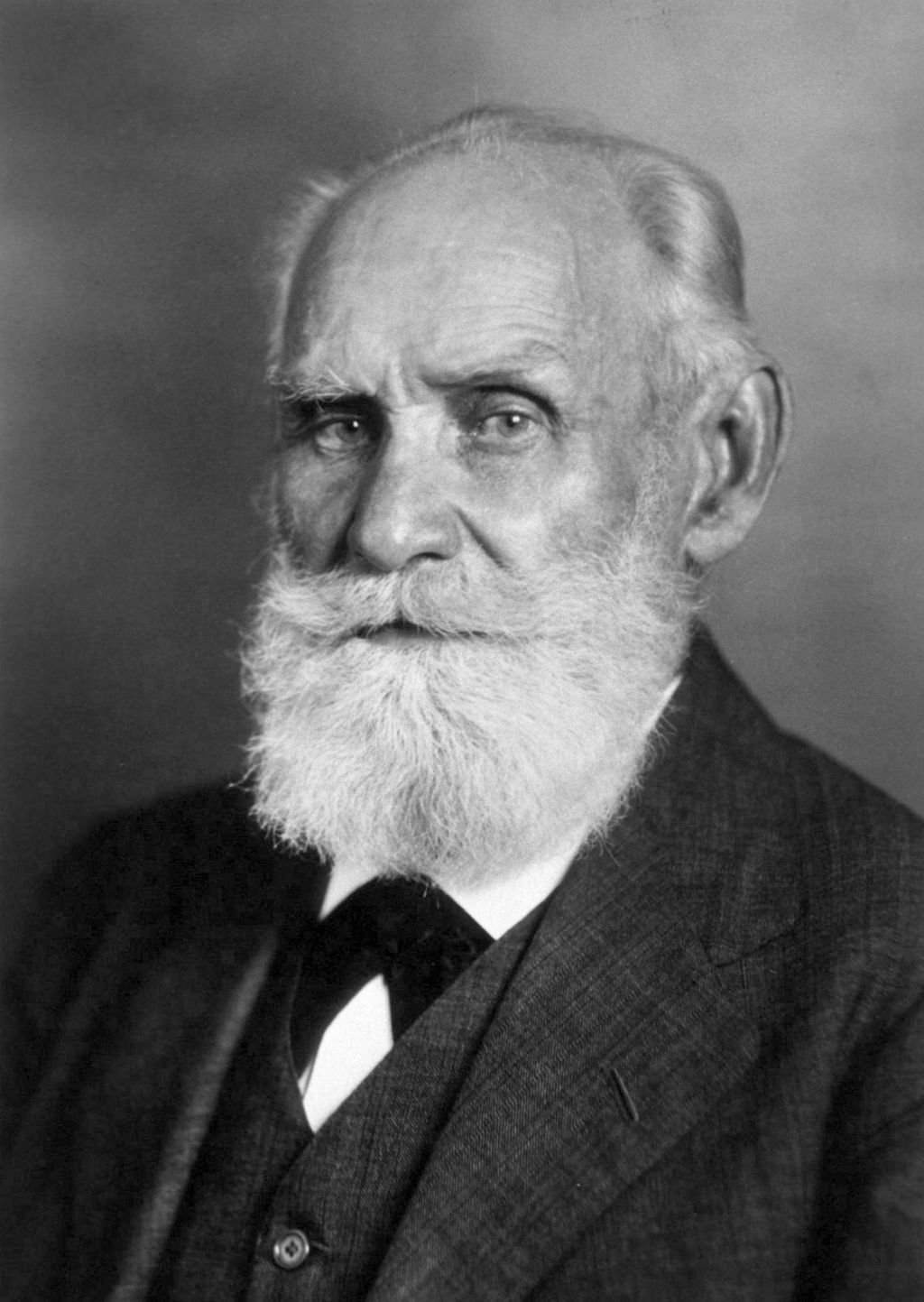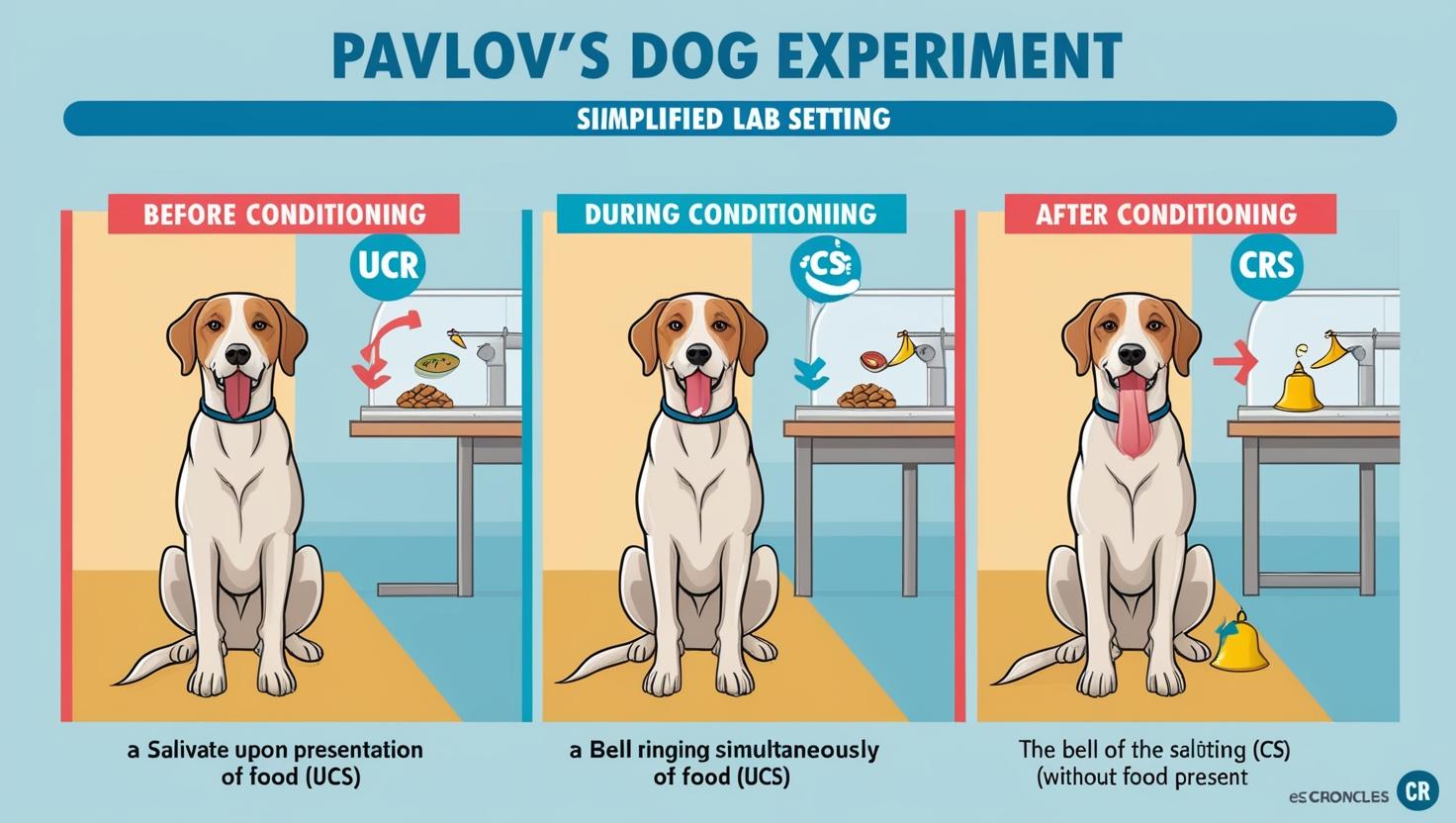Pavlov – Classical Conditioning
David Ludwig

Learning Objectives
By the end of this chapter, you will be able to…
- Identify key components of Classical Conditioning
- Differentiate Classical Conditioning from Operant Conditioning
- Identify uses of Classical Conditioning in education, therapy, and behavior modification
Introduction to Classical Conditioning
Overview
Classical Conditioning is a foundational learning theory that examines how behaviors emerge through associations between stimuli (Kanevsky, 2025). Developed by Ivan Pavlov in the 1890s, this theory arose from his observations of dogs salivating in response to cues linked to food. Pavlov discovered that pairing a neutral stimulus, such as a bell, with an unconditioned stimulus, like food, could eventually elicit the same automatic response independently (Stangor, 2014). His work established behaviorism and transformed our understanding of learning and behavior in psychology and education. This chapter explores Pavlov’s discovery, its principles, and its enduring influence across diverse fields.
Importance
Why does Classical Conditioning merit attention? This theory is significant because it clarifies how associations shape behavior. Classical Conditioning also provides valuable insights into learning processes that extend beyond experimental settings (Kanevsky, 2025). This theory illustrates that repeated experience can alter responses, and can be used in behavior modification, habit formation, and therapeutic interventions. Pavlov’s findings have informed practical strategies in both education and clinical practice (Stangor, 2014). Understanding its importance lays the foundation for exploring its historical origins.
For a concise overview of Classical Conditioning, watch this 5-minute video presentation:
Origins of Classical Conditioning
Founders
Ivan Pavlov, a Russian physiologist, discovered Classical Conditioning unexpectedly while researching digestion in dogs. Initially focused on salivation triggered by food, Pavlov observed that dogs began salivating in response to food cues such as footsteps or the sight of a dish. This observation led Pavlov to systematically pair neutral cues with food to illicit learned responses (Wikipedia, 2025). His innovative research earned him the Nobel Prize in Physiology or Medicine in 1904 for contributions to digestive studies. Additionally, Pavlov’s inquiry established a new paradigm in learning science (Stangor, 2014).
Historical Context
Pavlov’s work emerged in the early 20th century as psychology shifted toward empirical investigations of observable behavior. His experiments sparked the rise of behaviorism, a dominant psychological framework for decades (Wikipedia, 2025). By demonstrating that learning could be quantified through stimulus-response relationships, Pavlov influenced modern learning theories and behavioral psychology (Stangor, 2014). This historical context frames its distinction from other approaches, as examined next.
Comparison with Other Theories
Classical Conditioning is frequently confused with Operant Conditioning, however, their mechanisms diverge significantly. Classical Conditioning centers on forming associations between stimuli, such as a bell triggering salivation after being paired with food. While Operant Conditioning relies on reinforcement or punishment to shape behavior, such as rewarding a dog with a treat for sitting on command (Andover, 2013). In contrast to Cognitive Learning Theories, which emphasize mental processes like reasoning, Classical Conditioning prioritizes observable responses (Stangor, 2014). This differentiation underscores its unique contribution to learning theory.
Looking for a video explanation? Watch this 4-minute presentation by Peggy Androver:
Fundamental Tenets of Classical Conditioning
Classical Conditioning hinges on core principles that explain how learning develops through association. Established by Ivan Pavlov, these tenets reveal how a neutral stimulus acquires significance when paired with a naturally triggering stimulus, shaping behaviors over time (Kanevsky, 2025). The table below summarizes these components:
Key Concepts and Mechanisms (Kanevsky, 2025)
| Component | Example | Role In Conditioning |
| Unconditioned Stimulus (UCS) | Food | Naturally triggers response |
| Unconditioned Response (UCR) | Salivation | Automatic reaction |
| Conditioned Stimulus (CS) | Bell | Triggers response after pairing |
| Conditioned Response (CR) | Salivation | Learned response |
Classical Conditioning begins by pairing an Unconditioned Stimulus, such as food, with a neutral one, such as a bell. Over time, this teaches the brain to associate food with the sound of a bell. The bell alone can then trigger a learned reaction, like salivating, even without food. Repeated pairings strengthen this connection and build the brain’s expectation of food when the bell rings. Over time, the link between Unconditioned Stimulus and Conditioned Stimulus are strengthened (Stangor, 2014). Next, we’ll explore the strengths and limitations of Classical Conditioning.
Strengths and Limitations of Classical Conditioning
Strengths
Classical Conditioning provides a clear explanation of how associations form in learning and render it as a versatile tool across disciplines (Kanevsky, 2025). In therapy, techniques like exposure therapy can help patients overcome phobias. Classical Conditioning is utilized by pairing feared objects with relaxation and can gradually reduce anxiety. In education, Classical Conditioning can be employed by associating praise with task completion. This reinforcement can enhances student engagement, increase retention, and improve motivation (Walinga, 2025).
Limitations
Nevertheless, associations have their limitations. Classical Conditioning focuses exclusively on observable behavior and disregards internal cognitive processes such as reasoning or reflection (Walinga, 2025). This limited scope hampers its ability to address complex learning, such as problem-solving, where mental effort is critical. For instance, a student memorizing facts via repetition may not grasp their significance. Moreover, ethical concerns emerge when manipulating responses such as inducing fear in human or animal experiments. Such concerns prompt debates about the need for consent and an awareness of participant welfare (Stangor, 2014).
AI-Generated Case Study
How does Classical Conditioning apply in real settings? Consider this case study, co-created with Grok, a large-language model built by xAI:
At Sunnyside Elementary, fifth-grade teacher Ms. Carter faced daily chaos when the recess bell rang, prompting shouting and shoving among her students. Determined to restore order, she employed Classical Conditioning to address this common classroom challenge with a practical solution. She identified the bell as the unconditioned stimulus (UCS) naturally eliciting excitement, the unconditioned response (UCR), and introduced a soft whistle—blown three times—as a neutral stimulus. For two weeks, she paired the whistle with the bell, eventually making the whistle alone a conditioned stimulus (CS) that triggered a calm, orderly response, the conditioned response (CR). Praising the students for lining up quietly reinforced this shift. By the third week, the whistle alone ensured a peaceful transition to recess, offering a replicable strategy for educators. This example bridges theory to practice, as explored further in the next section.

Instructional Design Implications
Classical Conditioning shapes behavior by linking stimuli with responses, making it a valuable tool in instructional design. This approach can enhance engagement, motivation, and habit formation in learning environments. Carefully designed cues and reinforcements can guide learners toward desired behaviors in classrooms, therapy sessions, and corporate training (Kanevsky, 2025).
Strategies
Instructional designers can apply this theory in several ways (Kanevsky, 2025). A teacher might flash a bright light to signal students to begin a group project. In adult workshops, raising a hand before discussions can train teams to share ideas quickly. In online courses, a pop-up badge after task completion can boost engagement. Rewarding users with bonus time can encourage participation. During reading lessons, a short stretch break before story time can help children settle in. In virtual training, a bold checkmark after quizzes can reinforce focus.
Contexts
In education, Classical Conditioning reinforces positive behaviors, such as rewarding students for submitting assignments on time. In therapy, gradual exposure and desensitization techniques help individuals manage fears and anxieties. Workplace training programs use conditioned incentives, such as bonuses or recognition, to encourage productivity and adherence to protocols (Stangor, 2014). These applications demonstrate the theory’s adaptability across different learning and behavioral settings.
Exercises
Let’s check your understanding of Classical Conditioning:
Conclusion
Classical Conditioning, introduced by Ivan Pavlov, continues to shape our understanding of learning by demonstrating how associations influence behavior. From its accidental discovery in a lab to its widespread use in education, therapy, and beyond, this theory provides a framework for modifying responses through repeated exposure to stimuli. Its principles have contributed to practical applications such as behavior management, habit formation, and therapeutic interventions.
Despite its strengths, Classical Conditioning has limitations, particularly in addressing complex cognitive processes. However, advancements in neuroscience and technology offer new opportunities to refine and expand its applications. Future research may explore how digital tools, such as virtual reality or adaptive learning platforms, can enhance conditioning techniques for more effective behavior modification.
As you reflect on this theory, consider how Classical Conditioning appears in everyday life. How might you use it to encourage positive habits, reduce undesired behaviors, or improve learning experiences in your own environment?
References
Andover, P. (2013, March 7). TED-Ed: The difference between classical and operant conditioning [Video]. YouTube. https://www.youtube.com/watch?v=H6LEcM0E0io
Kanevsky, I. Classical conditioning. OER Commons. Retrieved January 26, 2025.
Sprouts. (2020, May 30). Pavlov’s classical conditioning [Video]. YouTube. https://www.youtube.com/watch?v=hhqumfpxuzI
Stangor, C. (2014). Learning by Association: Classical Conditioning. Introduction to psychology – 1st Canadian edition. BC Campus. https://opentextbc.ca/introductiontopsychology/
Wikipedia contributors. Ivan Pavlov. Wikipedia, The Free Encyclopedia. Retrieved January 28, 2025, from https://en.wikipedia.org/wiki/Ivan_Pavlov
License and Attribution
“Ivan Pavlov and Classical Conditioning” by David Ludwig, Idaho State University, is adapted from the following sources:
- Learning by Association: Classical Conditioning by Jennifer Walinga and Charles Strangor, licensed under CC BY-NC-SA
- The difference between classical and operant conditioning by Peggy Andover, licensed under CC BY-NC-ND 4.0 International
- Classical Conditioning by Inna Kanevsky, licensed under CC BY-NC-SA
- Pavlov’s classical conditioning. video by Sprouts, licensed under CC BY.
- Ivan Pavlov, Wikipedia, licensed under CC BY-SA
In honor of the license requirements from the sources used throughout, “Ivan Pavlov and Classical Conditioning” by David Ludwig is licensed under CC BY-SA-NC-ND.
AI Attribution: This work was created with an even blend of human and AI contributions. AI was used to make stylistic edits, such as changes to structure, wording, and clarity. AI was used to make content edits, such as changes to scope, information, and ideas. AI was prompted for its contributions, or AI assistance was enabled. AI-generated content was reviewed and approved. The following model(s) or application(s) were used: xAI Grok.
